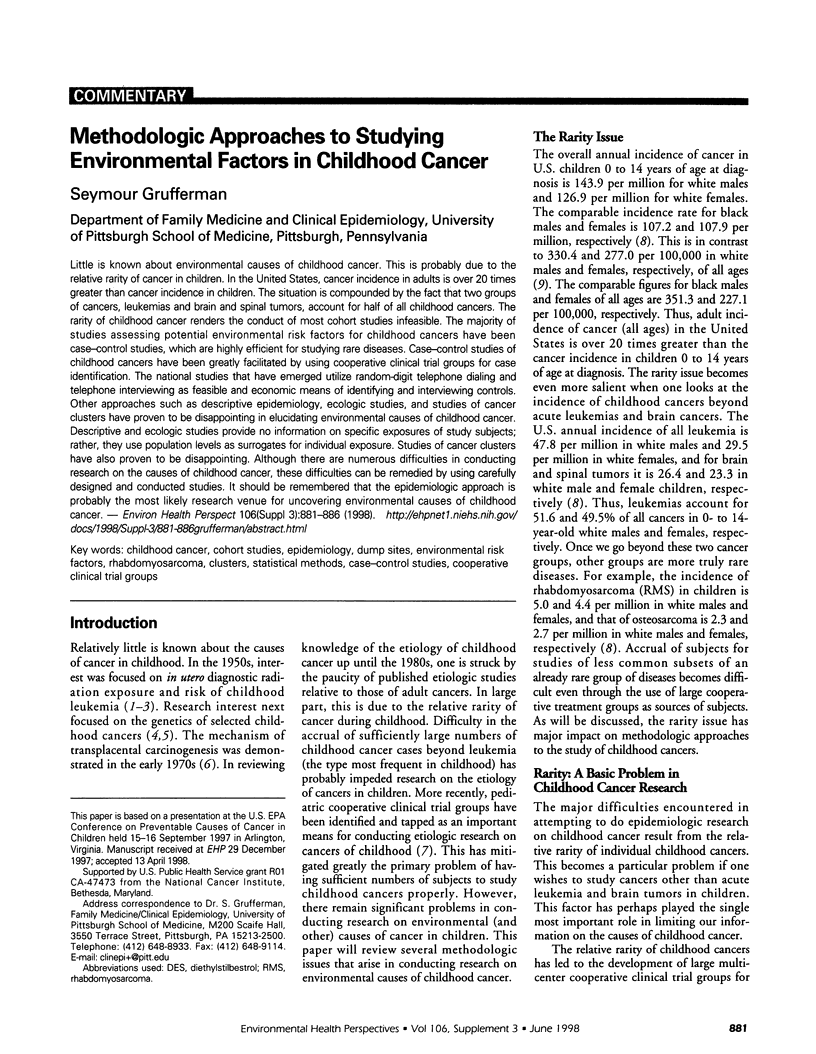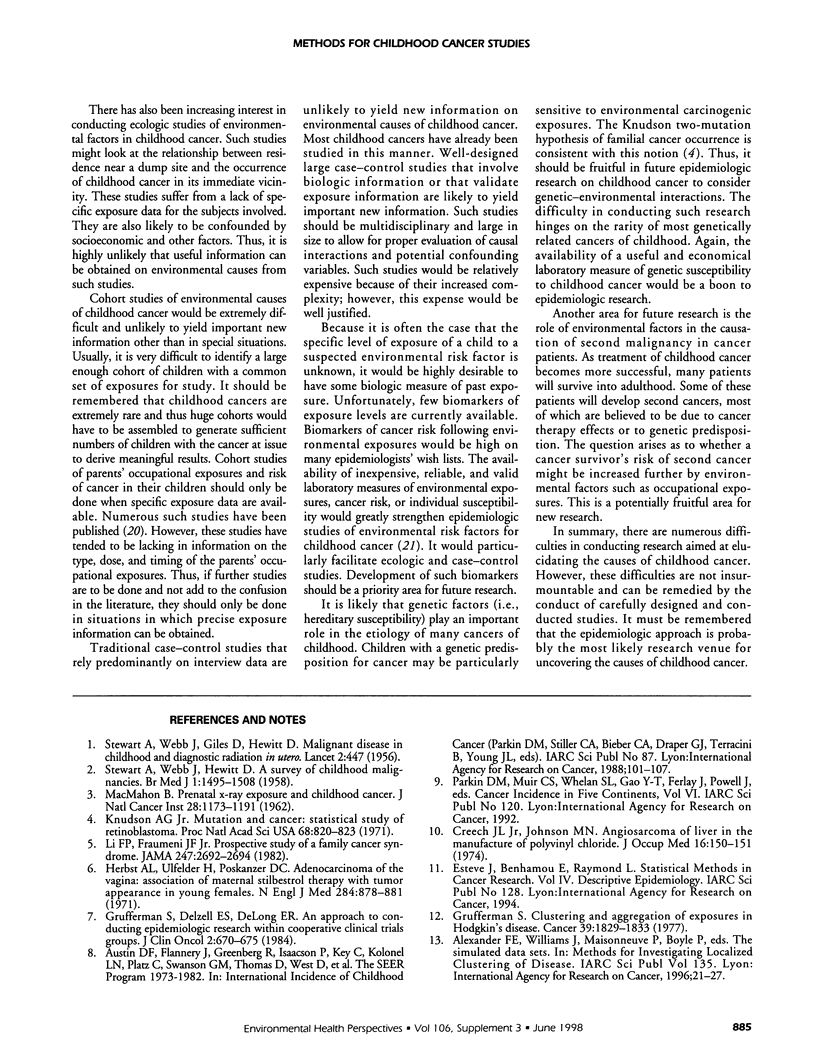Abstract
Little is known about environmental causes of childhood cancer. This is probably due to the relative rarity of cancer in children. In the United States, cancer incidence in adults is over 20 times greater than cancer incidence in children. The situation is compounded by the fact that two groups of cancers, leukemias and brain and spinal tumors, account for half of all childhood cancers. The rarity of childhood cancer renders the conduct of most cohort studies infeasible. The majority of studies assessing potential environmental risk factors for childhood cancers have been case-control studies, which are highly efficient for studying rare diseases. Case-control studies of childhood cancers have been greatly facilitated by using cooperative clinical trial groups for case identification. The national studies that have emerged utilize random-digit telephone dialing and telephone interviewing as feasible and economic means of identifying and interviewing controls. Other approaches such as descriptive epidemiology, ecologic studies, and studies of cancer clusters have proven to be disappointing in elucidating environmental causes of childhood cancer. Descriptive and ecologic studies provide no information on specific exposures of study subjects; rather, they use population levels as surrogates for individual exposure. Studies of cancer clusters have also proven to be disappointing. Although there are numerous difficulties in conducting research on the causes of childhood cancer, these difficulties can be remedied by using carefully designed and conducted studies. It should be remembered that the epidemiologic approach is probably the most likely research venue for uncovering environmental causes of childhood cancer.
Full text
PDF





Selected References
These references are in PubMed. This may not be the complete list of references from this article.
- Alexander F. E., Williams J., Maisonneuve P., Boyle P. Methods for investigating localized clustering of disease. The simulated data-sets. IARC Sci Publ. 1996;(135):21–27. [PubMed] [Google Scholar]
- Creech J. L., Jr, Johnson M. N. Angiosarcoma of liver in the manufacture of polyvinyl chloride. J Occup Med. 1974 Mar;16(3):150–151. [PubMed] [Google Scholar]
- GILES D., HEWITT D., STEWART A., WEBB J. Malignant disease in childhood and diagnostic irradiation in utero. Lancet. 1956 Sep 1;271(6940):447–447. doi: 10.1016/s0140-6736(56)91923-7. [DOI] [PubMed] [Google Scholar]
- Grufferman S. Clustering and aggregation of exposures in Hodgkin's disease. Cancer. 1977 Apr;39(4 Suppl):1829–1833. doi: 10.1002/1097-0142(197704)39:4+<1829::aid-cncr2820390815>3.0.co;2-a. [DOI] [PubMed] [Google Scholar]
- Grufferman S., Delzell E. S., Maile M. C., Michalopoulos G. Parents' cigarette smoking and childhood cancer. Med Hypotheses. 1983 Sep;12(1):17–20. doi: 10.1016/0306-9877(83)90028-2. [DOI] [PubMed] [Google Scholar]
- Grufferman S., Delzell E., Delong E. R. An approach to conducting epidemiologic research within cooperative clinical trials groups. J Clin Oncol. 1984 Jun;2(6):670–675. doi: 10.1200/JCO.1984.2.6.670. [DOI] [PubMed] [Google Scholar]
- Grufferman S., Schwartz A. G., Ruymann F. B., Maurer H. M. Parents' use of cocaine and marijuana and increased risk of rhabdomyosarcoma in their children. Cancer Causes Control. 1993 May;4(3):217–224. doi: 10.1007/BF00051316. [DOI] [PubMed] [Google Scholar]
- Grufferman S., Wang H. H., DeLong E. R., Kimm S. Y., Delzell E. S., Falletta J. M. Environmental factors in the etiology of rhabdomyosarcoma in childhood. J Natl Cancer Inst. 1982 Jan;68(1):107–113. [PubMed] [Google Scholar]
- Herbst A. L., Ulfelder H., Poskanzer D. C. Adenocarcinoma of the vagina. Association of maternal stilbestrol therapy with tumor appearance in young women. N Engl J Med. 1971 Apr 15;284(15):878–881. doi: 10.1056/NEJM197104222841604. [DOI] [PubMed] [Google Scholar]
- Knox E. G., Gilman E. A. Spatial clustering of childhood cancers in Great Britain. J Epidemiol Community Health. 1996 Jun;50(3):313–319. doi: 10.1136/jech.50.3.313. [DOI] [PMC free article] [PubMed] [Google Scholar]
- Knudson A. G., Jr Mutation and cancer: statistical study of retinoblastoma. Proc Natl Acad Sci U S A. 1971 Apr;68(4):820–823. doi: 10.1073/pnas.68.4.820. [DOI] [PMC free article] [PubMed] [Google Scholar]
- Li F. P., Fraumeni J. F., Jr Prospective study of a family cancer syndrome. JAMA. 1982 May 21;247(19):2692–2694. [PubMed] [Google Scholar]
- MACMAHON B. Prenatal x-ray exposure and childhood cancer. J Natl Cancer Inst. 1962 May;28:1173–1191. [PubMed] [Google Scholar]
- STEWART A., WEBB J., HEWITT D. A survey of childhood malignancies. Br Med J. 1958 Jun 28;1(5086):1495–1508. doi: 10.1136/bmj.1.5086.1495. [DOI] [PMC free article] [PubMed] [Google Scholar]


